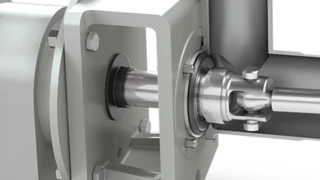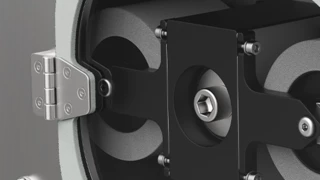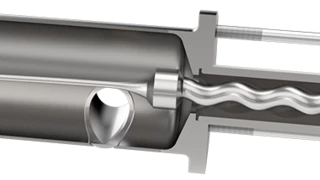WINE Transfer Pump
TORNADO® rotary lobe pump ensures precise and gentle conveyance of wine from cellar to bottler
How to prevent contamination or oxidation in wine production
It usually takes only one sip after opening a bottle of wine to determine whether it will be the perfect addition to a pleasant evening or go straight down the drain. To prevent the latter, precision and diligence are required during the entire production and bottling process in order to ensure consistent quality across all types.
A delicious cool glass of wine is a delightful treat on a balmy summer evening. But producing a high-quality wine involves a number of challenges. Due to their delicate nature, wines are considered a difficult pumping medium because even minor reactions like unwanted foaming during bottling can have a significant impact on the wine.

Individual Consulting

Risks and challenges when pumping wine
A reputed winery also demands this from the technology provider to ensure that undesirable reactions such as oxidation or foaming do not occur when the base wine is transferred from the secondary tank to the filler for the tirage. This can significantly impact the purity and taste of the wine as excessive contact with oxygen and mechanical swirling distort the delicate aromas and the structure of the wine. The company was using a rotary lobe pump with a gearbox, which required oil as a lubricant, for this transfer task. The pumps pose an unnecessary risk because contamination with lubricant oil would mean that the entire production batch has to be discarded. The winery therefore decided to replace the old pump as a preventive measure and contacted the technical experts from NETZSCH. Thanks to its many references, the worldwide active company with headquarters in Germany is globally regarded as a point of reference for small and large wineries who need pump technology that does not damage the product while ensuring reliability and low operating costs.
No contamination with lubricants thanks to the oil-free belt drive
The company is looking for a pump with good suction power and precise dosing for transporting the product without foaming. In addition to this, they wanted it to be mounted on a trolley – like the previous pump – so it could be moved between tanks.
How to sustainably increase your efficiency when pumping wine
After initial discussions and a visit to the future place of use, NETZSCH recommended TORNADO® T.Sano® to the winery: These models are designed specifically for pumping sensitive media in environments with high hygiene standards. As a unique, oil-free belt drive acts as the motor in these pumps, contamination of the product with lubricant is excluded. To meet the high requirements, the pump design was adapted to prevent foaming and maintain the flavour integrity of the wine. “Following our principle of ‘You have the application, we have the solution!’, the pump was designed in such a way that the shape of the rotors avoids unnecessary swirling of the product. In addition, the chambers' volume is tailored exactly to the typical flow rates of 3,500 – 8,000 l/h at this winery to avoid excess mechanical influence on the wine and ensure optimum flow rate without pulsations or shear forces.
At the same time, the pumps design has no gaps, screws or other areas where the medium, i.e. the wine, could stagnate. This means that an accumulation of residue and impurities cannot occur in the first place. These would be difficult to remove and could significantly impact the quality of the wine. The wine is in constant and even motion, and precise dosing or flow rate control is ensured. This presents two advantages: Firstly, the bottles can be filled with exactly the same amount of fluid each time. Secondly, this solution saves wine and money without great effort, which optimises the production process.
Efficient cleaning and maintenance without disassembly
The new pump requires little maintenance. Our commitment to quality is exceptionally high in this area as well, which is why we focus on a low-maintenance design for our pumps so that our promise of Proven Excellence is utilized in all areas. Operators can use the proven cleaning-in-place (CIP) process and subsequently the sterilization-in-place (SIP) process to ensure efficient cleaning. These allow the system to be cleaned and sterilized using a circulation or flow-through process – no disassembly required. If smaller maintenance tasks are required despite the long service life, these can be carried out without having to remove the pump from the pipe, thanks to the FSIP® solution. The setting device installed in front of the pump cover can be used to position the rotary lobes optimally after maintenance, without any expensive special tools.
And even if a part needs to be replaced, NETZSCH can react quickly and reliably: In addition to a 24-hour emergency service, which includes service as well as technical support, the company keeps sufficient stock of parts so that downtime can be kept as low as possible, no matter where in the world the pumps are being used, or old units from other manufacturers have to be replaced with new systems. We can ensure this thanks to our global network of more than 2,500 employees at five development and production sites as well as 30 sales companies and more than 200 NETZSCH representatives.
TORNADO® T.Sano® all-metal rotary lobe pump








